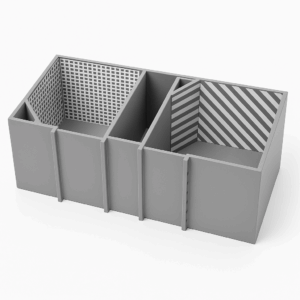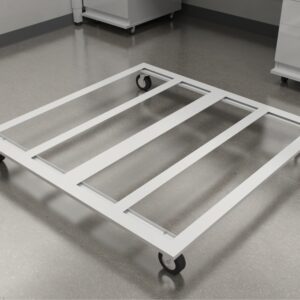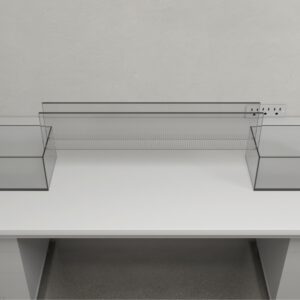$1,790.00 – $1,990.00Price range: $1,790.00 through $1,990.00
The sociobox is an acrylic device featuring a central open arena encircled by five rectangular removable boxes, each separated by fixed dividers. Experimental rodents are placed in the central arena, while stimulus mice occupy the inserts in the surrounding outer ring. This setup facilitates the testing of social interactions.

MazeEngineers empowers preclinical neuroscience research with meticulously designed, customizable behavioral apparatuses. From manual classic mazes to fully automated smart systems, we provide the tools scientists need to capture high-quality, reproducible data for studies on learning, memory, anxiety, and depression.



Mouse Features | |
Outer Ring Diameter: 56cm | |
Inner Ring Diameter: 34cm | |
Height of the inserts: 20.5cm | |
Insert Width: 8.5cm | |
Insert Length: 11.5cm | |
Insert Height: 20.5cm | |
Insert: Maze color; with front clear. 31 holes of 0.8cm diameter for social interaction. | |
White circular partition for initiation stage: Diameter 19cm; Height 18cm |
Rat Features | |
Outer Ring Diameter: 75cm | |
Inner Ring Diameter: 45cm | |
Height of the inserts: 27cm | |
Insert Width: 11cm | |
Insert Length: 15cm | |
Insert Height: 27cm | |
Insert: Maze color; with front clear. 31 holes of 1cm diameter for social interaction. | |
White circular partition for initiation stage: Diameter 25cm; Height 24cm |

The SocioBox is a behavioral apparatus designed to evaluate social functioning and recognition in animals. It is akin to the Sociability Chamber, which measures an animal’s interest in novel objects or unfamiliar conspecifics. The SocioBox provides a robust assessment of social recognition deficits.
Social connectivity and recognition are vital to emotional well-being, but these processes can be disrupted by various mental health disorders, including schizophrenia, autism, bipolar disorder, and depression. Rodent models offer valuable insights into the mechanisms underlying social dysfunction, as well as the prognosis and treatment of these psychological conditions. Similar to humans, rodents can display complex social behaviors (Bevins & Besheer, 2006).
Developed by Krueger-Burg et al. (2016), the SocioBox consists of a circular chamber in which the test animal is placed. This central arena is encircled by an outer ring containing unfamiliar stimulus rodents. Both the subject and the stimulus animals interact and exchange scents through small holes in the front panels of the inserts. An overhead camera records the movements and interaction times of the test rodent.
The apparatus is first cleaned with running water or wet wipes, dried, and then disinfected with 70% ethanol. It is then rinsed again with tap water to eliminate any residual ethanol odor and dried thoroughly. This cleaning process is repeated after each experiment to remove debris and olfactory cues.
An overhead camera (Noldus Ethovision XT) is positioned approximately 130 cm above the apparatus to automatically record the animals’ movements.
The subjects are maintained under standard conditions in a separate room. However, they are exposed to light (10-15 lux) for about 30 minutes just before the task to acclimate them to the lighting conditions used during testing.
Three days prior to the task, the subject and stimulus animals are placed individually in the SocioBox without any food or water restrictions to help reduce anxiety associated with the novel environment.
The subject is then introduced to the central arena and allowed to explore the setup for 10 minutes each day. During this initial exploration phase, no stimulus animals are present in the inserts. After five minutes of exploration, the circular partition is removed to simulate the test environment.
The stimulus animals undergo separate habituation. Each stimulus animal is placed in an insert, which is then positioned in the outer slot of the SocioBox. Pre-training consists of three habituation sessions per day, with each session lasting 10 minutes. During the last five minutes of habituation, the circular partition in the central arena is removed to replicate the conditions of the test session.
Task Protocol
The task involves placing stimulus rodents in the inserts and transferring the apparatus to the testing room, leaving behind just insert (6th insert) in the same light conditions. This insert is introduced in the recognition test phase.
The test session lasts for 10 minutes and consists of three phases: Exposure 1, Exposure 2, and the Recognition Test.
In Exposure 1, the subject is placed in the central arena and stimulus animals in the inserts. After five minutes, the circular partition is lifted to let the subject interact freely with the stimulus animals.
The subject is then removed from the arena and the apparatus cleaned in the prescribed manner.
In Exposure 2, the subject is placed back in the central arena for similar initiation and interaction as Exposure 1. After 10 minutes, it is removed, and the apparatus is cleaned.
At this stage, any insert is replaced with the 6th stimulus animal placed in the other room.
In the Recognition Test, the subject is returned to the circular partition and test is repeated.
The subject and stimulus animals are then returned to their home cages, and the apparatus is cleaned. It is important not to use any stimulus animal for more than three sessions in a row. This is likely to induce fatigue and social disinterest.
Sociobox can be used to study psychiatric diseases such as autism and schizophrenia which lead to social withdraw and inability to build a social network. (Krueger-Burg et al., 2016)
Macbeth, Edds, & Young (2009) showed that the test apparatus could be satisfactorily used to study the roles of the neuropeptides oxytocin and vasopressin in social recognition. Oxytocin and vasopressin play an important role in learning and short-term memory recall.
Compared to males, female rodents are less able to distinguish between stimulus subjects and show recognition for the new animal (Miczek, Maxson, Fish, & Faccidomo, 2001). The gender differences in social behavior are interesting and worth pursuing.
The main purpose of SocioBox is to test social recognition in the subjects. For this purpose, Krueger-Burg et al. (2016) selected healthy juvenile mice of 3-6 weeks old. In the circular behavioral chamber, the mouse of interest interacted freely with the unfamiliar mice held in rectangular inserts. The movement of the subject was recorded and the interaction time was calculated.
In the first part of the experiment, the experimental mouse exhibited remarkable interest in all stimulus mice, but the interest waned in the repeated exposure. Instead, it was seen spending more time with the new stimulus animal reflecting the ability to differentiate between the old and the new encounter. The researchers concluded that Sociobox could identify social recognition problems in animals and recognize the subtle disease-related changes.
The subject behaviors are analyzed every 10 minutes. The following social behaviors are observed during the test:
Social behaviors are scored as Social Recognition Index (SRI) by plotting a graph between the exposure of each subject animal and the interaction time (seconds).
Data analysis is done on the following parameters:
Social Recognition Index
Spatial Heat Map: Mean localization of animals in a given test
Temporal Distance Heat Map: Distance of the subject from the point of origin in the first 5 minutes of each test phase
Besheer, J., & Bevins, R.A. (2006). Object recognition in rats and mice: a one-trial non-matching-to-sample learning task to study ‘recognition memory.‘ Nat Protoc, 1(3), 1306-11. http://dx.doi.org/10.1038/nprot.2006.205
Daher, F., Dere, E., Ehrenreich, H., Krueger-Burg, D., Mitkovski, M., Ronnenberg, A.,… Winkler, D. (2016). The SocioBox: A Novel Paradigm to Assess Complex Social Recognition in Male Mice. Front Behav Neurosci, 11, 10-151. http://dx.doi.org/10.3389/fnbeh.2016.00151
Edds, J.S., Macbeth, A.H., & Young, W.S. (2009). Housing conditions and stimulus females: a robust social discrimination task for studying male rodent social recognition. Nat Protoc, 4(11), 1574-81. http://dx.doi.org/10.1038/nprot.2009.141
Faccidomo, S., Fish, E.W., Maxson, S.C., & Miczek, K.A. (2001). Aggressive behavioral phenotypes in mice. Behav Brain Res, 125(1-2), 167-81. Retrieved from https://www.ncbi.nlm.nih.gov/pubmed/11682108/
| Species | Mouse, Rat |
|---|
There are no questions yet. Be the first to ask a question about this product.